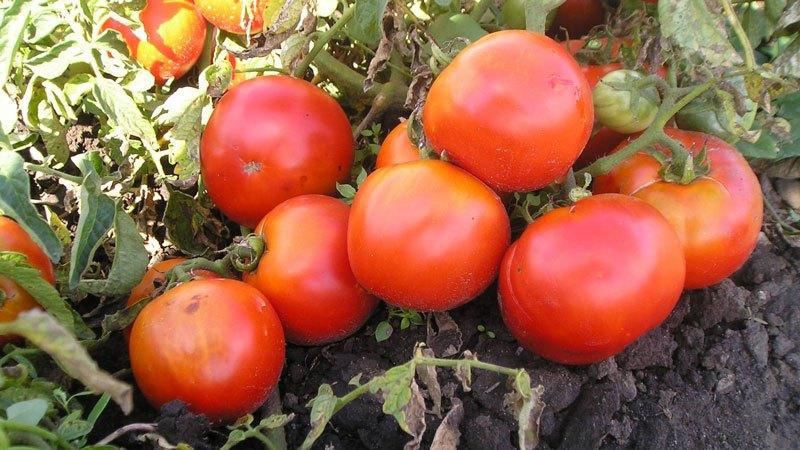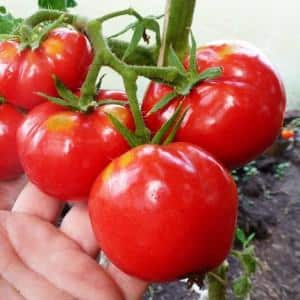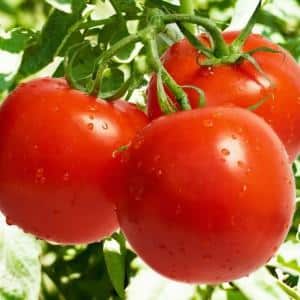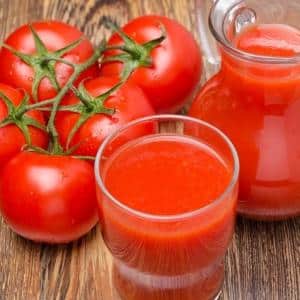Hybrid tomato for canning and salads: tomato “Anastasia”
For gardeners who dream of getting a good harvest in the open ground, breeders developed the Anastasia tomato variety. This hybrid has strong immunity to major crop diseases and tolerates cold and prolonged absence of sun. Let's look at a detailed description of the Anastasia tomato variety.
Description of the variety
Variety Anastasia is a type of hybrid. Appeared as a result of crossing different varieties. Has good frost resistance. Ripens within 105-110 days from the moment the seedlings are planted in the ground.
Bushes are limited in growth, determinant. The height of one in open conditions reaches an average of 110 cm. In a greenhouse, the bushes grow up to 130 cm. Anastasia is also grown under film.

Not to be confused with namesakes
The Anastasia variety has several namesakes. Do not under any circumstances confuse Anastasia and the Nastenka variety. Nastenka is also a hybrid, but only an early ripening one, ripens within 80 days. The Nastenka variety is a determinate bush, the maximum height of which is 60 cm. The tomatoes are large, red, the weight of one is about 200 g.
There is another variety called Nastya-Slastena. The hybrid is famous for its tasty fruits and ease of care. The ripening period is early, the first harvest is obtained after 90 days. The height of the bushes is about 110 cm, but in a greenhouse it reaches more. Gardeners harvest about 2.5 kg of tomatoes from one Nastya-Slastena bush.
Important! The main difference between varieties is the ripening time.
Distinctive features
Anastasia matures quickly and can handle long-distance transportation without problems. Thanks to this, tomatoes are often grown not only for personal consumption, but also for sale.
The growth and development of plants is practically not affected by soil fertility: an excellent harvest is obtained even in soils with a small amount of nutrients. The hybrid must be tied to supports and excess shoots must be periodically removed.
Characteristics of tomatoes, yield
Tomatoes at ripe stage Green colour, then gradually acquire a rich red color. The weight of one tomato is from 130 to 180 g. The shape is round, the peel is dense and glossy. The pulp is juicy and soft. The fruits of the Anastasia variety do not crack and have a good shelf life.
Productivity is high. Subject to all growing rules, from 1 sq. m, gardeners harvest about 20 kg of ripe and tasty tomatoes.
How to grow seedlings
Seedlings are prepared at the end of March or beginning of April. Before this, you need to prepare the seeds, soil and growing container.
Seed preparation
 Hybrid seeds can be purchased in a store or ordered by mail. As a rule, the bags contain all the information about the manufacturer and planting recommendations. Trust only trusted suppliers. To be on the safe side, consult your garden neighbors and find out which supplier is best to purchase seed from.
Hybrid seeds can be purchased in a store or ordered by mail. As a rule, the bags contain all the information about the manufacturer and planting recommendations. Trust only trusted suppliers. To be on the safe side, consult your garden neighbors and find out which supplier is best to purchase seed from.
Next you need to carry out disinfection. To do this, use hydrogen peroxide. Although purchased seeds are already pre-treated, disinfection will not be superfluous. Soak the seeds in damp gauze or cotton pad.This will increase the immunity of the material and create favorable conditions for growing in the future.
Container and soil
 Containers for seedlings are sold in the store. These are special containers for seedlings, cassettes or flower pots. You can save money and plant seeds in ordinary wooden boxes or plastic jars. The main thing is to wash them and dry them first.
Containers for seedlings are sold in the store. These are special containers for seedlings, cassettes or flower pots. You can save money and plant seeds in ordinary wooden boxes or plastic jars. The main thing is to wash them and dry them first.
The situation is similar with soil. Some prepare the soil themselves. To do this, you will need a mixture of soil, peat, humus, ash and sand in a ratio of 4:1:1:1:1. Mix all the elements and disinfect with a manganese solution. Water the soil with warm water and once dry, begin planting the seeds.
In order not to waste time and effort, some gardeners purchase a ready-made mixture for seedlings. It already contains all the necessary vitamins and minerals; it does not need to be further disinfected.
An excellent option is “Krepysh” soil. Purchase such material at any specialized gardening store.
Sowing
When the seeds and soil are ready, start sowing. Pour soil into a container, make small holes about 1 cm deep in it. Place the seed in them and sprinkle soil on top. Next, pour in plenty of warm water.
To create the best conditions, cover the seedlings with film or glass. This will create the desired microclimate. Remove the film little by little over two weeks. This way the sprouts will get used to the air temperature and humidity level.
Growing and care
Seedlings should be grown in a warm and bright place. Without the right amount of light, the stems develop very slowly. Use growth stimulants - they will give the plant additional strength.
Water the seedlings very carefully.Do not allow the soil to dry out or become waterlogged. It is better to spray the sprouts with a small amount of water, otherwise they will develop late blight or signs of rot. The ideal temperature for growing is about 20 degrees.
How to grow tomatoes
After the seedlings have sprouted, proceed to the stage of transplanting the plants into the ground.
Landing
 Prepare the beds before planting. They must be clean, free of foreign debris and other plants. It is recommended to dig up the soil in the fall and loosen it in the spring. Also make sure that the soil does not contain remnants of previous diseases.
Prepare the beds before planting. They must be clean, free of foreign debris and other plants. It is recommended to dig up the soil in the fall and loosen it in the spring. Also make sure that the soil does not contain remnants of previous diseases.
A week before planting, it is recommended to add mineral and organic fertilizers to the soil. For example, add sand and peat, and then level the soil with a rake. For disinfection, it is recommended to water the beds with hot water.
As soon as the beds are ready, proceed to transplanting the sprouts. The holes should be located at a distance of about 40-60 cm from each other. Place the sprouts in them with lumps of the old soil on the roots. When you plant the bed, water the soil with warm water. Make sure that water does not get on the leaves. It is better to plant tomatoes in the morning or evening.
Important! The final stage of planting is the installation of pegs that will serve as support for the bushes. The height of each must be at least 1 m.
Care
It is necessary to water the bushes every 5-6 days. Pay attention to weather conditions as well. If it rains frequently, reduce the amount of water. If it's a hot and dry summer, increase it. The main thing is to remember that excess moisture leads to cracking of the fruit and the development of many diseases.
Important! The Anastasia variety is not protected from the formation of stepsons.Remove shoots carefully so as not to damage the remaining stems. Some gardeners recommend doing this with gloves.
 Remove weeds periodically. To create the best conditions, cover the beds with dry leaves. Also, do not forget to loosen the soil every 7-10 days. As soon as the fruit begins to set, tie the stems to the stakes. Otherwise, the branches will break under the weight of the vegetables.
Remove weeds periodically. To create the best conditions, cover the beds with dry leaves. Also, do not forget to loosen the soil every 7-10 days. As soon as the fruit begins to set, tie the stems to the stakes. Otherwise, the branches will break under the weight of the vegetables.
Don't forget about applying fertilizers. The first feeding is carried out 10 days after planting. The hybrid responds well to fertilizing based on ammonium nitrate, potassium salt, and other nitrogen-containing substances. Ordinary organic compounds, such as humus and liquid mullein, perform well as fertilizers.
Features of cultivation and possible difficulties
It is also necessary to tie up the Anastasia variety so that insects do not feast on fruits that come into contact with the ground. In addition, the garter provides the tomatoes with air ventilation between the bushes and comfortable watering plants.
In addition to pegs for garter, you will need ribbons. It is best to use synthetic material, as it does not rot, which means it attracts less insects. It is better not to use ropes and wire for garters.
If Anastasia's leaves become dry and turn yellow, it means the plant lacks magnesium. A solution of Epsom salts or magnesium nitrate will help correct the situation. If the leaves have a pinkish tint, the bushes do not have enough sulfur. Replenish its deficiency with magnesium sulfate.
Diseases and pests
Among insects, the hybrid is most often attacked by wireworms. It penetrates the root system and destroys the roots of the bush, eating them. As a result, the bush dies, and the wireworm moves to another plant.There is also another pest called whitefly. This small insect looks similar to a white moth. The whitefly attacks the tomato in a flock, sits on the leaves and feeds on them. Spraying with whey or garlic solution helps get rid of pests.
Of the diseases, the worst enemy of all tomatoes deserves special attention - late blight. It appears as brown spots on the leaves, which are very difficult to get rid of. The hybrid can also get blackleg. This fungus appears as a result of soil contamination and penetrates the weakest stems. To prevent it, it is recommended to monitor the light and watering regime and loosen the soil.
The nuances of growing in open ground and in a greenhouse
 Regardless of the growing conditions, it is worth disinfecting the soil in advance. And in greenhouse – additionally disinfect all hard surfaces. Attention is paid even to the pegs and garters. It is better to prepare new material every year, as traces of infections may remain on last year’s pegs.
Regardless of the growing conditions, it is worth disinfecting the soil in advance. And in greenhouse – additionally disinfect all hard surfaces. Attention is paid even to the pegs and garters. It is better to prepare new material every year, as traces of infections may remain on last year’s pegs.
The hybrid gives a good harvest in open ground, so do not forget about fertilizers and fertilizing. The best helpers for this are calcium nitrate and eggshells, humus, urea and manure.
It is recommended to fertilize every 10-15 days. At the same time, study the appearance of the bushes. Pay attention to the color and shape of the leaves - this will help you understand what exactly the tomatoes are missing.
Harvesting and application
Anastasia is collected as it ripens. Sometimes the bushes contain rich dark red tomatoes that are not yet ripe at the stage of milky ripeness. After collection, it is recommended to store them in wooden boxes, cover the top with paper or a lid.
Tomatoes are used to prepare various dishes. The taste of the hybrid is perfect for pizza, julienne, salads and vegetable stews, and tomato juice. Tomatoes are also eaten fresh.
Advantages and disadvantages of the variety
Advantages of the variety:
- taste;
- immunity to disease;
- good ovary of tomatoes even in unfavorable climate;
- long shelf life;
- versatility in application;
- stability during transportation.
The disadvantages include mandatory garters and stepsoning.
Farmer reviews
Let's see what experienced farmers and beginners say about the Anastasia variety.
 Oleg, Vladimir: “Every year I grow 4-5 different varieties of tomatoes on my plot. I can say that Anastasia is my favorite tomato. It grows well in the open air and does not get sick. For the best harvest, I fertilize it with liquid mullein and humus. It ripens gradually, the tomatoes are sweet, the taste is excellent.”
Oleg, Vladimir: “Every year I grow 4-5 different varieties of tomatoes on my plot. I can say that Anastasia is my favorite tomato. It grows well in the open air and does not get sick. For the best harvest, I fertilize it with liquid mullein and humus. It ripens gradually, the tomatoes are sweet, the taste is excellent.”
Mira, Rostov region: “I learned about this variety not long ago and decided to try planting it in my garden. I can't say that he impressed me very much. The seed manufacturer promised large tomatoes, but the maximum weight I got for one was 90 g. The taste was bland because it rained a lot. I don’t know if I’ll grow it again.”
Svetlana, Saratov: “I love hybrids because they rarely get sick. I’ve been growing Anastasia for the third year in a row, and I’m happy with the harvest. Of course, the variety is inferior to those hybrids that do not need garter. Otherwise, the vegetables fully correspond to the stated description.”
Conclusion
Getting a good harvest of the Anastasia variety is not difficult. The main thing is to follow the watering schedule and tie the stems in time. As befits a hybrid, the tomato has high disease resistance. However, it would still be a good idea to take preventive measures.Vegetables are stored for a long time and do not spoil. The main advantage of the variety is that a rich harvest is obtained in the open air, and not just in a greenhouse.